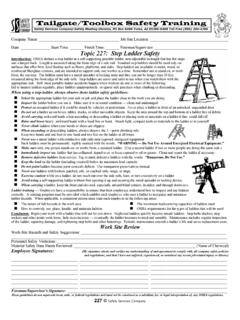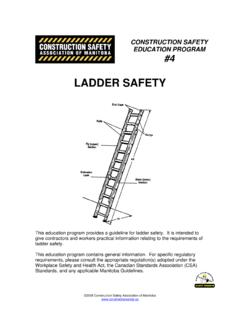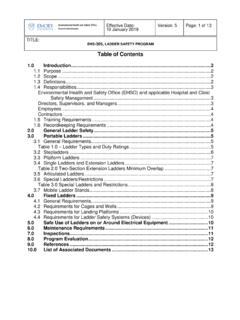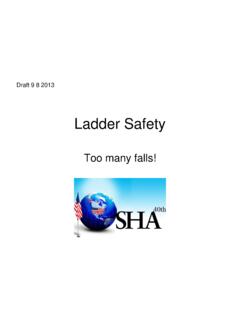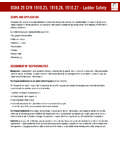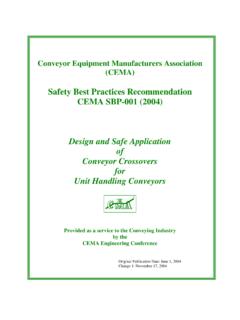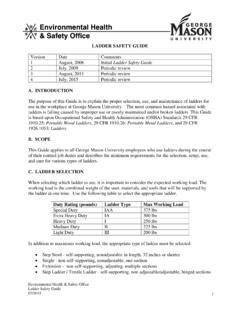Transcription of LADDER SAFETY - rm.rutherfordcountytn.gov
1 LADDER SAFETYI ntroductionLadders are a very handy tool, both at work and around the home. Ladders are such simple tools that many people forget the dangers involved when using a LADDER . This training program is designed to provide information on the proper selection, use and maintenance of ladders to help keep you safe. Load RatingsLadders are rated according to their load capacity. Type IAA Commercial grade, heavy duty use. Weight capacity of 375 IA Industrial, heavy duty use. Weight capacity of 300 I Industrial, general use. Weight capacity of 250 II light commercial use.
2 Weight capacity of 225 pounds. Should not be used in construction or general industry settings!Type III Household, light use. Weight capacity of 200 pounds. Should not be used in construction or general industry settings!Types of LaddersTwo types of portable ladders: Step ladders (A-Frame)-Used mainly for tasks closer to the ground. Straight or extension ladders-Used to access high, tight areas where it s only possible to get two LADDER feet on solid, level ground. Portable ladders can be made from different materials: Wood, Metal (Aluminum) or Fiberglass. Selecting the Right LadderTo meet OSHA loading and strength requirements, all ladders should meet or exceed American National Standards Institute (ANSI) standards.
3 Follow your company s LADDER SAFETY Policy and Guidelines. Consult with manufacturer s guidelines on the possible and appropriate uses of the LADDER . Make sure the LADDER is of sufficient Rules for LADDER Use Always inspect the LADDER for damages before use. Maintain 3-points of contact with the LADDER . Have at least both hands and one foot or both feet and one hand in contact with the LADDER at all times. Always keep your belt buckle between the LADDER rails. This keeps your center of gravity in a safe zone. Keep ladders free of oil, grease and other slipping hazards.
4 Never load a LADDER beyond the maximum intended load or the manufacturer s rated capacity. Use only for the designed purpose. Use ladders on a stable and level surface. Have only one person on the LADDER at a time. Do not move, shift or extend ladders while in use. Never use a metal LADDER on or around electrical elements. Always face the LADDER when moving up or down. Use both hands when going up or down the Rules for LADDER Use Do not use the top or top step as a step or seat. Do not use cross bracing on back side of LADDER for climbing or any other purpose. Paint tray should only be used for paint trays or cans.
5 Spreaders must be fully extended and locked before use. Never use a step LADDER as a straight for Step Ladders After raising LADDER to desired height, lock sides in place. Side rails must extend at least 3 feet above upper landing surface. For every four feet in height from the ground to where the LADDER is touching the support at the top, the bottom of the LADDER should be one foot away from the wall. This is known as the 4-to-1 rule. Example: if the LADDER is resting against a 16 foot wall, the base of the LADDER should be placed 4 feet out from the wall. Never stand on the top three rungs.
6 Never place against movable objects. Rules for Straight LaddersLadders that are damaged or defective can be very dangerous. OSHA requires all portable ladders found to have structural defects immediately be marked or tagged DO NOT USE and taken out of use until LaddersLadders repairs must be done by the manufacturer or other qualified person and must restore the LADDER to a condition meeting its original design criteria. If a LADDER cannot be properly repaired it must be destroyed and a LADDER correctly is important in maintaining the integrity. Ladders should be stored vertically whenever possible.
7 If a LADDER must be stored horizontally, it should be supported in several places to keep the rails form sagging. Never store ladders somewhere that cause them to become a tripping hazard. Store ladders in a cool, dry place. Avoid hot, wet areas or other conditions that could compromise the integrity of the StorageAlong with this training booklet, your employer will provide additional training to ensure you know how to use ladders correctly. You need to be able to recognize hazards related to ladders and know how to minimize those hazards. Proper use, placement and care in handling of all ladders and maximum intended load-carrying capacities of ladders RequirementsQuizClick on the link below to take a 10-Question Quiz.
8 You have linked to the quiz, please enter your Social SecurityNumber at the top. You will need to enter it according to the example shown (ex. 999-99-9999 with hyphens included). Once finished with the questions, please click the submit button and your training will be : It takes 90 days for newly hired employees to be loaded to the training database. In this case print out the quiz and submit to your supervisor or SAFETY training point of contact.
